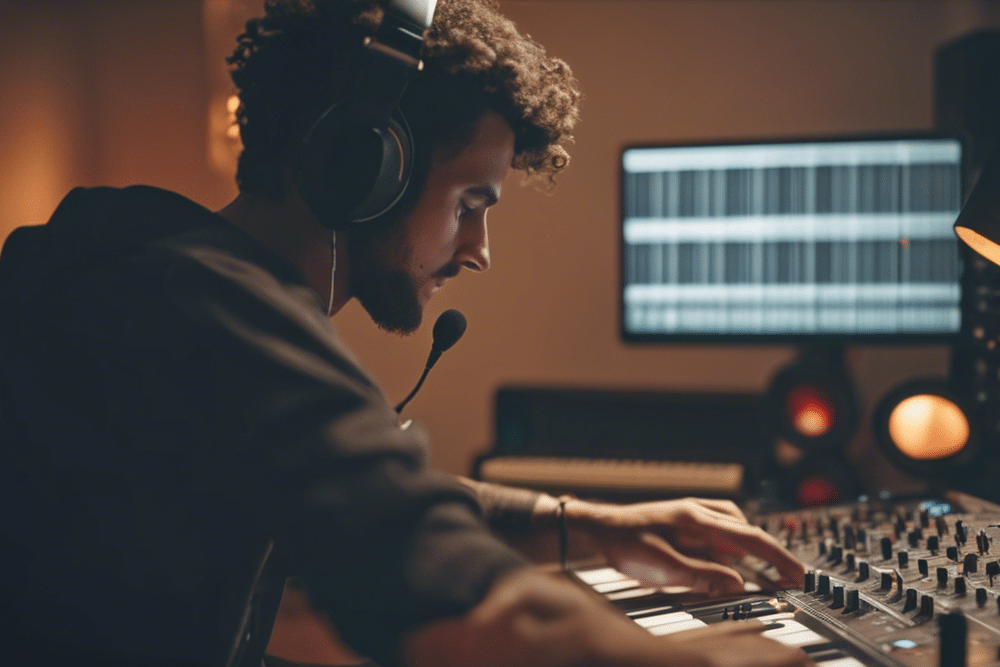Estimated reading time: 10 minutes
Introduction: Elevating Your Vocal Performances
As a music producer, you know that achieving pitch-perfect vocals can make or break a track. Whether you’re working on a chart-topping hit or a personal project, the ability to fine-tune vocal performances is crucial. Enter Autotune – a powerful tool that has become a staple in modern music production. In this comprehensive guide, we’ll explore how to use Autotune in FL Studio, one of the most popular digital audio workstations (DAWs) among producers.
FL Studio offers various options for vocal tuning, including native plugins and third-party VST plugins. We’ll dive deep into the world of Autotune, covering everything from basic setup to advanced techniques that will help you create professional-grade vocal tracks. Whether you’re new to FL Studio or a seasoned user, this guide will provide valuable insights to enhance your music production skills.
Table of contents
- Introduction: Elevating Your Vocal Performances
- Understanding Autotune: More Than Just a Pitch Correction Tool
- Setting Up Autotune in FL Studio
- Basic Autotune Settings in FL Studio
- Advanced Autotune Techniques in FL Studio
- Integrating Autotune with Other FL Studio Features
- Troubleshooting Common Autotune Issues in FL Studio
- Best Practices for Using Autotune in FL Studio
- Video: How to use autotune in fl studio 20 – 5 TIPS YOU NEED
- Conclusion: Mastering Autotune for Professional-Grade Productions
- FAQs
Understanding Autotune: More Than Just a Pitch Correction Tool
Before we delve into the specifics of using Autotune in FL Studio, it’s essential to understand what Autotune is and how it works.
What is Autotune?
Autotune is a pitch correction software that automatically detects and adjusts the pitch of a vocal or instrumental recording. Initially developed by Antares Audio Technologies, the term “Autotune” has become synonymous with vocal pitch correction in general, much like how “Kleenex” is often used to refer to all facial tissues.
How Does Autotune Work?
At its core, Autotune analyzes the incoming audio signal and compares it to a user-defined scale or set of notes. If it detects that the pitch of the audio is slightly off, it adjusts it to the nearest correct note. This process happens in real-time, allowing for immediate results during recording or mixing.
The Impact of Autotune on Music Production
Since its introduction in the late 1990s, Autotune has revolutionized the music industry. It has become an indispensable tool for music producers, allowing them to:
- Correct minor pitch imperfections in vocal performances
- Create the distinctive “Autotune effect” popularized in many contemporary genres
- Experiment with creative vocal effects and styles
Setting Up Autotune in FL Studio
Now that we have a basic understanding of Autotune, let’s explore how to set it up in FL Studio.
Native Pitch Correction Options in FL Studio
FL Studio comes with several built-in tools for pitch correction:
- Newtone: A comprehensive pitch and time editor
- Pitcher: A real-time pitch correction and harmonization plugin
- FL Studio’s built-in pitch correction features in the audio clip properties
While these native options are powerful, many producers prefer to use third-party Autotune plugins for their advanced features and familiar interfaces.
Installing Third-Party Autotune Plugins
To use a third-party Autotune plugin in FL Studio, follow these steps:
- Purchase and download your chosen Autotune plugin (e.g., Antares Auto-Tune Pro, Melodyne, or Waves Tune)
- Install the plugin on your computer
- Open FL Studio and go to Options > File Settings
- In the “Plugin search paths” section, make sure the folder containing your new plugin is included
- Restart FL Studio to complete the installation process
Adding Autotune to Your Vocal Track
Once you have your Autotune plugin installed, here’s how to add it to your vocal track:
- Load your vocal recording into FL Studio
- In the Mixer, select the channel containing your vocal track
- In the insert effects area, click on an empty slot
- Navigate to the Autotune plugin in the plugin picker and select it
Your Autotune plugin should now be active on your vocal track, ready for customization.

Basic Autotune Settings in FL Studio
With Autotune added to your vocal track, it’s time to explore the basic settings that will help you achieve the desired pitch correction.
Key and Scale Selection
One of the most critical settings in any Autotune plugin is the key and scale selection. This tells the plugin which notes are “correct” for your song. To set this:
- Determine the key of your song
- In the Autotune plugin interface, find the key and scale settings
- Select the appropriate key and scale (e.g., C Major, A Minor)
Pro Tip: If you’re unsure of your song’s key, use FL Studio’s built-in key detection feature or consult with a musician friend.
Retune Speed
The retune speed determines how quickly Autotune corrects pitch deviations. A faster speed results in a more robotic, obvious effect, while a slower speed sounds more natural.
- For subtle, natural-sounding correction: Use a slower retune speed (20-50ms)
- For the distinct “Autotune effect”: Use a faster retune speed (0-10ms)
Experiment with different retune speeds to find what works best for your track.
Humanize or Natural Vibrato
Many Autotune plugins offer a “humanize” or “natural vibrato” feature. This helps maintain some of the natural variations in the vocal performance, preventing the tuned vocals from sounding too perfect or robotic.
Advanced Autotune Techniques in FL Studio
Once you’ve mastered the basics, you can explore more advanced Autotune techniques to fine-tune your vocal productions.
Graphical Pitch Editing
Most advanced Autotune plugins offer a graphical interface for detailed pitch editing. This allows you to:
- Manually adjust the pitch of specific notes or phrases
- Remove or enhance vibrato
- Create pitch effects that would be impossible to sing naturally
To access this feature, look for a “graph” or “edit” mode in your Autotune plugin.
Formant Shifting
Formant shifting allows you to alter the character of the voice without changing its pitch. This can be useful for:
- Making a voice sound more masculine or feminine
- Creating alien or robotic vocal effects
- Matching the timbre of different vocal takes
Experiment with formant shifting to add depth and character to your vocal productions.
Using Autotune for Harmony Creation
Many Autotune plugins can generate harmonies based on your lead vocal. Here’s how to create simple harmonies:
- Duplicate your lead vocal track
- Add Autotune to the new track
- In the Autotune settings, look for a harmony or pitch-shifting option
- Choose the desired interval (e.g., a third or fifth above the original)
This technique can quickly add richness to your vocal arrangements.

Integrating Autotune with Other FL Studio Features
To get the most out of Autotune in FL Studio, it’s important to understand how it interacts with other aspects of the DAW.
Using Autotune in the Channel Rack
While it’s common to add Autotune as an insert effect in the Mixer, you can also use it in the Channel Rack for more flexibility:
- In the Channel Rack, right-click and select “Add one”
- Choose your Autotune plugin
- Route your vocal audio to this new Autotune channel
This method allows you to easily apply Autotune to multiple vocal tracks or create parallel processing setups.
Automating Autotune Parameters
FL Studio’s powerful automation features can be used to create dynamic Autotune effects:
- Right-click on a parameter in your Autotune plugin
- Select “Create automation clip”
- Edit the automation clip in the Playlist view
Try automating the retune speed to switch between natural and effect-heavy sections of your track.
Combining Autotune with Other Vocal Effects
Autotune works well in combination with other vocal effects. Consider this signal chain for a polished vocal sound:
- Noise Gate (to remove background noise)
- Autotune (for pitch correction)
- EQ (to shape the tone)
- Compression (to even out the dynamics)
- Reverb (to add space and depth)
Experiment with different effect combinations to find your signature vocal sound.
Troubleshooting Common Autotune Issues in FL Studio
Even experienced producers can run into issues when using Autotune. Here are some common problems and their solutions:
Latency Issues
If you’re experiencing latency when using Autotune in real-time:
- Go to Options > Audio Settings
- Reduce the buffer length
- If possible, use ASIO drivers for your audio interface
Autotune Not Detecting the Correct Pitch
If Autotune seems to be correcting to the wrong notes:
- Double-check that you’ve set the correct key and scale
- Ensure that your input signal is clean and not too quiet
- Try adjusting the input type setting (e.g., soprano, alto, tenor, bass)
CPU Overload
If Autotune is causing CPU spikes:
- Increase your buffer length (at the cost of some latency)
- Freeze or bounce tracks that don’t need real-time Autotune processing
- Consider using a less CPU-intensive Autotune plugin for some tracks
Best Practices for Using Autotune in FL Studio
To wrap up our comprehensive guide, let’s review some best practices for using Autotune in your FL Studio projects:
Start with a Good Recording
Autotune works best on well-recorded vocals. Invest in a good-quality audio interface and microphone, and take the time to capture the best possible performance.
Use Autotune Subtly
Unless you’re going for an obvious effect, use Autotune sparingly. The goal is often to enhance the vocal, not to completely transform it.
Experiment with Different Autotune Plugins
While Antares Auto-Tune is the original, there are many great Autotune plugins available. Try different options to find the one that best suits your workflow and sound.
Combine Automatic and Manual Tuning
For the best results, use Autotune’s automatic features for general pitch correction, then fine-tune problem areas manually using graphical pitch editing.
Consider the Genre and Style
Different genres have different expectations when it comes to vocal tuning. A pop track might use more obvious Autotune effects, while a folk song might require more subtle correction.
Trust Your Ears
While Autotune can fix pitch issues, it’s important to trust your ears. If something sounds good, even if it’s not perfectly in tune, consider leaving it as is.
Video: How to use autotune in fl studio 20 – 5 TIPS YOU NEED
Conclusion: Mastering Autotune for Professional-Grade Productions
Autotune has become an essential tool in modern music production, and FL Studio provides an excellent platform for harnessing its power. By understanding the basics of how Autotune works, exploring its various features, and integrating it seamlessly into your FL Studio workflow, you can elevate your vocal productions to new heights.
Remember, Autotune is just one tool in your production arsenal. Use it wisely, in combination with solid recording techniques and thoughtful arrangement, to create truly compelling music. With practice and experimentation, you’ll develop your own unique approach to using Autotune in FL Studio, helping you craft professional-grade vocal tracks that stand out in today’s competitive music landscape.
Whether you’re correcting minor pitch imperfections, creating lush harmonies, or experimenting with creative vocal effects, the techniques and tips outlined in this guide will help you make the most of Autotune in FL Studio. So fire up your DAW, load up your favorite Autotune plugin, and start exploring the possibilities. Your perfect vocal track awaits!
Related Posts
FAQs
Autotune is pitch correction software that adjusts the pitch of vocal or instrumental recordings to match a defined scale. It analyzes the audio signal and automatically shifts off-pitch notes to the nearest correct note, making performances sound polished and in-tune.
To set up Autotune in FL Studio, first install your chosen plugin. Then, go to Options > File Settings, and add the plugin’s folder to your plugin search paths. Restart FL Studio and add the Autotune plugin to your vocal track in the Mixer.
Key settings include selecting the song’s key and scale to guide pitch correction, adjusting the retune speed for a natural or robotic sound, and using features like “humanize” to retain natural vocal characteristics
Duplicate your lead vocal track and add Autotune to the new track. Use the harmony or pitch-shifting options to create intervals like thirds or fifths above the original vocal, adding depth and richness to your vocal arrangement.
For latency, reduce buffer length and use ASIO drivers. If the wrong pitch is detected, verify the key and scale settings. To handle CPU overload, increase buffer length, freeze tracks, or use less CPU-intensive plugins.
